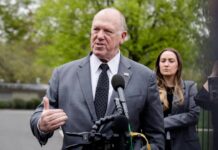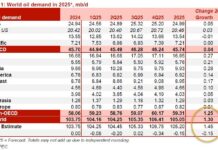Trump’s Commerce Secretary Howard Lutnick said in a closely watched CNBC interview today that he has a trade deal with an unnamed country awaiting approval. Speculation about which country to sign immediately arose, with India, South Korea and Japan being named as the most likely candidates.
Of the three, India is the country most likely to announce the first major trade deal with the Trump administration, not only because of Apple’s decision to move all US-centric iPhone production from China to India, but also because there is a certain regional great power rivalry between India and China, with the former recently overtaking the latter as the world’s most populous country (China is facing a multi-decade crippling demographic crisis that would rival Japan’s) and with ambitions to surpass China’s GDP within the next two decades.
For example, Indian trade negotiators plan to highlight the country’s large stock of Boeing aircraft orders and potential for new orders in an attempt to secure a favorable deal with the United States, Bloomberg reported, citing sources familiar with the matter. Without a deal, India’s goods exports to the United States will face tariffs of up to 26% after Trump’s 90-day pause on reciprocal tariffs ends in July.
The plan is to take into account existing orders and pending contracts from Indian airlines with the American aircraft manufacturer in negotiations for a bilateral trade agreement, which could potentially protect the country from higher US tariffs.
Along with Air India, Akasa Air operator SNV Aviation and SpiceJet have ordered a total of 590 planes from Boeing in recent years, worth $67 billion. With deliveries and payments for the 506 planes spread over several years, India is keen to highlight how these private purchases would help reduce New Delhi’s more than $47 billion trade surplus with Washington – a key complaint of President Donald Trump.
Underscoring how India hopes to use planes as leverage in the global trade war, Air India, a former state-owned carrier acquired by the Tata Group in 2022, is already looking to acquire Boeing planes, which Chinese airlines rejected as part of a challenge to Trump’s reciprocal tariffs. The airline is also in talks with the American planemaker for new orders.
The growing number of Boeing-related orders from Indian airlines is also boosting the American planemaker’s market share in the South Asian market. Of the nearly 900 commercial airliners registered in India, 538 are mostly from Airbus SE’s 320 family, according to data consultancy KnowIndia.net. Only 140 are Boeing 737s, with the rest made up of wide-body, turboprop and other types of aircraft. While India’s largest carrier, IndiGo, operates an Airbus fleet, it decided last year to lease some Boeing 787s for some international routes.
India is not alone in seeking to use aircraft orders as a bargaining chip in trade negotiations. Vietnam is also using similar tactics to win favor with the White House.
While Prime Minister Narendra Modi pledged to buy more US goods, including crude oil, liquefied natural gas and defence supplies, when he met Trump in Washington in February, officials believe that adding private jet deals to the list could strengthen New Delhi’s case for a trade deal with the US.
The Modi administration has already offered the US several concessions, including reforming its tariff regime to reduce duties on about 8,500 industrial goods, including key American exports such as bourbon whiskey and high-end motorcycles such as those made by Harley Davidson.
In addition to the planes, India also hopes to appease Trump by increasing the amount of oil it imports from the US.
Indian refiners, which have relied heavily on Russian oil in recent years, have increased their purchases of US crude ahead of trade talks between the two countries next month. About 11.2 million barrels of US crude are expected to arrive in India in June, the highest volume since August last year, according to analyst firm Kpler. This comes after benchmark West Texas Intermediate prices fell on lower demand due to a major overhaul at a Singapore refinery and reduced appetite in China, the world’s largest oil importer.
“WTI needs to be discounted significantly more than usual to incentivize the rest of Asia to buy barrels,” said June Goh, senior oil market analyst at Sparta Commodities. “There is also a geopolitical element where Asian buyers may seek more WTI as a bargaining chip with the US to reduce reciprocal tariffs, as we are seeing with Indonesia and India.”
India’s trade deficit widened more than expected in March as oil imports jumped more than 60% in the month. The country’s exporters have urged officials in New Delhi to sign a bilateral trade deal with the United States as soon as possible. In-person talks are expected to begin in the second half of May after President Donald Trump this month halted a planned 26% tariff on the Asian country.
State refiners including Indian Oil Corp and Bharat Petroleum have bought at least 6 million barrels of crude oil for June delivery from the United States through various tenders held this month, according to Bloomberg calculations.
Bharat Petroleum – which is also looking to source local supplies, including types of oil from the US – has bought 1 million barrels of crude for the four months to September. Indian Oil has also started buying crude for July, including 3 million barrels from the US.






















